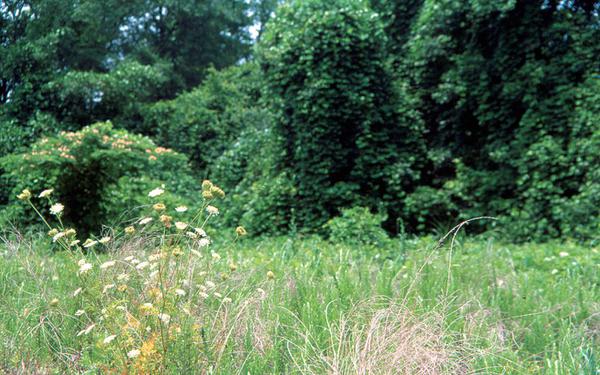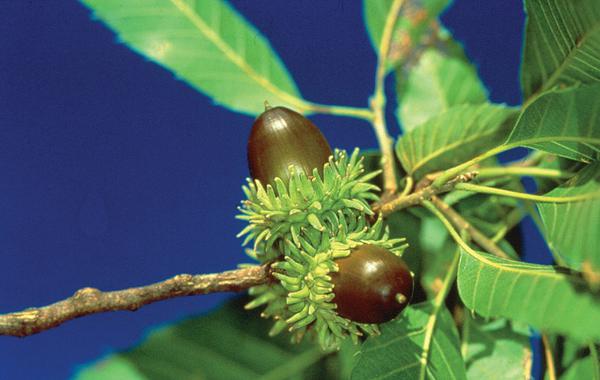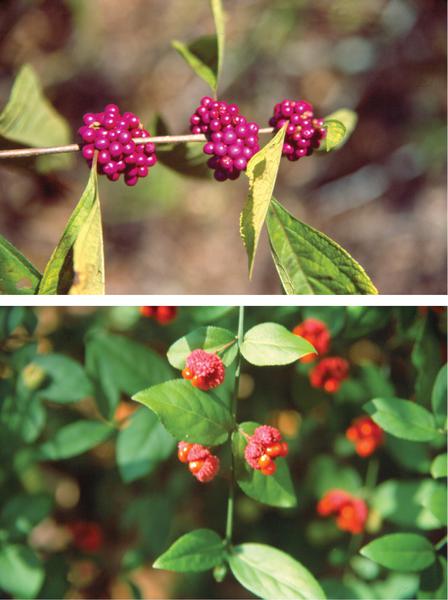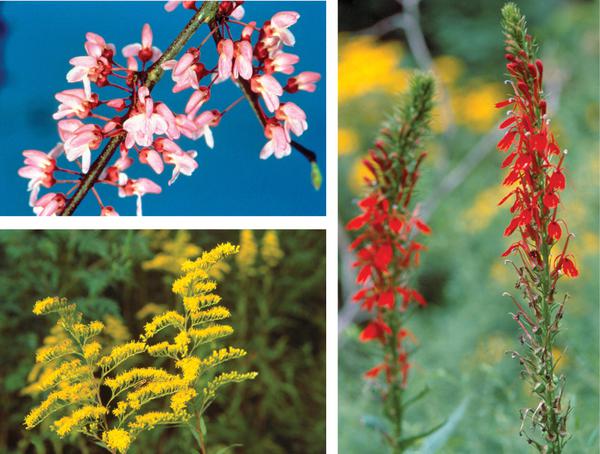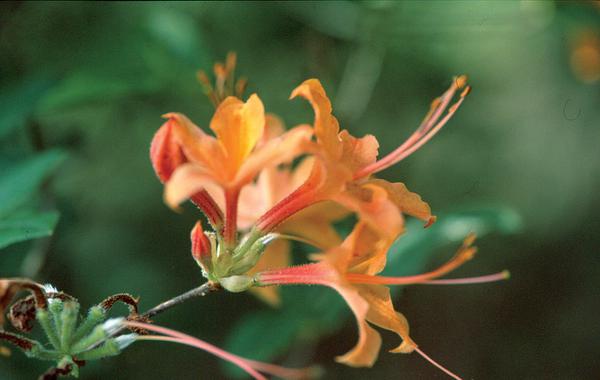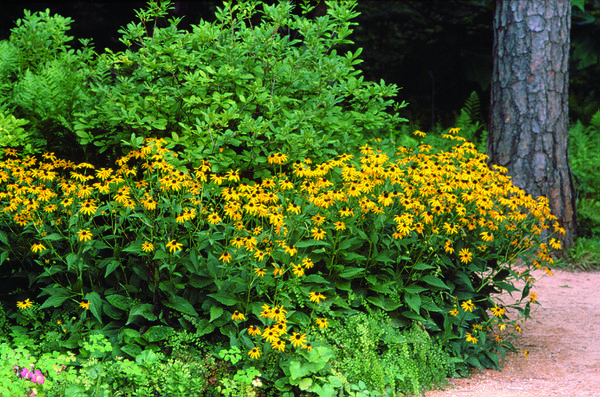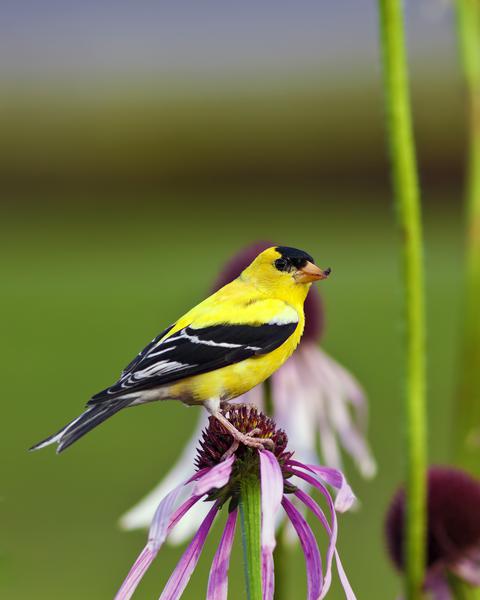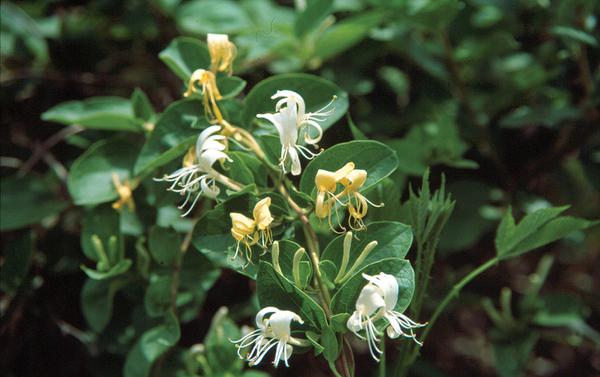North Carolina’s native plants provide well-adapted food and cover for North Carolina’s native animals, and a well-planned landscape of native plants can help you attract a diversity of wildlife to your property (Figure 1). Plants native to North Carolina also are well-suited to the state’s soils and climate, and they require relatively little upkeep once established on an appropriate site. However, the spread of non-native plants poses a threat to native plants and animals of North Carolina. This publication describes the problems associated with some non-native, invasive plants and presents a detailed list of native plants that may be used in place of these foreign ornamentals to attract wildlife to your property.
Why Use Native Plants?
Biologists and other scientists consider invasion by non-native plants to be one of the most serious problems facing native plant and wildlife populations in the United States. For example, multiflora rose, bicolor lespedeza, Japanese honeysuckle, and autumn olive are examples of non-native plants introduced into North Carolina—all for the purpose of promoting “wildlife habitat.” However, each introduction has proven detrimental to North Carolina’s native plants, pushing them out of their traditional habitats; and recent research indicates that many invasive plants may be harmful to local wildlife as well.
- Native plants generally are defined as those that occurred in North America before European settlement.
- Non-native plants are those not native to an area. In North Carolina, non-natives usually come from Asia or western Europe, regions that have similar climate and environmental conditions to those in this state.
- Some non-natives are planted intentionally as lawn or garden ornamentals or as plants to attract wildlife, but other non-native plants were introduced accidentally.
- Many non-native species become naturalized, which means they are able to survive, spread, and reproduce on their own.
- Approximately 25 percent of the plants growing wild in the United States are naturalized non-natives, some of which have become invasive, that is, they grow unabatedly where native plants otherwise would occur.
Invasive non-native plants are those that pose the greatest risk to the native plants and animals of North Carolina. Competitors, diseases, and insects control a plant’s growth and dispersal in its native range.
Over thousands of years, natural checks and balances develop, which greatly reduce the chance that a single species will increase in number to completely dominate a plant community. However, when a non-native plant is introduced to North Carolina, it escapes its natural controls and can become invasive (Figure 2). The characteristics that make many non-native plants attractive as ornamentals (colorful berries, pest resistance, tolerance of harsh conditions) also increase their potential for invasiveness and make them difficult to contain. Prolific growth by a single plant species can be harmful because forests with a limited number of plant species provide very poor habitat for wildlife.
All non-native plants do not become invasive, and many can safely be planted as ornamentals. However, it takes scientists many years or even decades to fully understand an introduced plant’s potential invasiveness. New information is being gathered continually, and you should check with your local nature center, botanical garden, conservation organization, or Cooperative Extension agent about a plant’s invasiveness before introducing it to your property.
Ironically, non-native plants that are attractive to birds and other wildlife often are the most invasive because animals serve as great dispersers of their fruits and seeds. Autumn olive is a non-native plant that produces fruits favored by birds, but the plant grows and spreads quickly where the seeds are defecated. Native fruit-producing plants may succumb to the competition from this type of invasive plant, thereby reducing the diversity of foods available to birds. In addition, research from the midwestern United States suggests birds that nest in some non-native shrubs experience poor nesting success. Lower nest height, the absence of sharp thorns on the non-native plants, and a branching pattern that allows predators easier access to nests built in non-native plants all contributed to the increased nest predation. Despite the growing base of knowledge related to the potential problems of non-native plants, species like sawtooth oak (Quercus acutissima) continue to be recommended as plantings to encourage wildlife (Figure 3). Until adequate information on the invasiveness of such plants exists, native alternatives should be used (Figure 4).
Reversing the Trend
You can help stop the non-native plant invasion by using and nurturing native plants around your home and on your property. Native plants generally grow well and require less care than non-native species when grown on the proper soils under the right environmental conditions. Additionally, North Carolina’s native wildlife has become adapted to using native plants over thousands of years. Therefore, native plants meet the needs, including food and cover, of North Carolina’s native wildlife without causing long-term damage to local plant communities.
Many native plants produce showy flowers, abundant fruits and seeds, and brilliant fall foliage. A diversity of native plants in an urban landscape provides:
- Protective cover for most animals.
- Seeds, nuts, and fruits for squirrels and other mammals.
- Seeds, fruits, and insects for birds.
- Nectar for hummingbirds and butterflies (Figure 5).
- Larval host plants for butterfly caterpillars (many caterpillars are adapted to eat the foliage of specific plants, called their host plants).
Table 1 contains examples of native trees, shrubs, and herbs beneficial to wildlife. Use the table to identify native alternatives to the non-native plants commonly recommended to attract wildlife. For example, consider a viburnum (Viburnum spp.) or holly (Ilex spp.) in place of autumn olive, or consider one of our dozens of native oaks (Quercus spp.) in place of sawtooth oak, which has been introduced from Asia (Figure 6).
Traditional landscape plantings don’t fully mimic the dense foliage and high plant diversity of natural areas. Therefore, birds and butterflies are most likely to use native plants that grow naturally in unmowed or unmanicured portions of your yard or in adjacent natural areas. Allow native grasses and forbs, brambles, and shrubs to grow in small corners of your yard where neighbors will be less likely to see the “unsightly” growth. These areas provide nest sites, cover, and food for birds and commonly harbor host plants for butterfly caterpillars. Minimize the amount of lawn on your property because these areas require frequent use of water, fertilizer, and pesticides that can be harmful to the environment and the very insects you want to attract. Before making drastic changes that might upset your neighbors, describe your plan to them and explain why you intend to make the changes.
Table 1. Plant species native to North Carolina* (including soil moisture and light requirements, region of primary occurrence, and benefit to wildlife).
Soil moisture: W = wet; M = moist; D = dry.
Light requirements: F = full sun; P = partial shade; S = shade.
Region: M = mountains; P = piedmont; CP = coastal plain.
Wildlife Value: C = winter cover; F = fleshy fruit; S = seed, hard mast, or catkin; H = hummingbird nectar; N = butterfly and other insect nectar; L = butterfly larvae host plant.
| Plant Type | Latin Name | Common Name** | Soil/Light | Region | Wildlife Value |
|---|---|---|---|---|---|
| Tall trees (more than 30 ft) | Acer barbatum | Southern Sugar Maple | M/F-S | P,CP | S |
| Acer rubrum | Red Maple | W-D/F-P | M,P,CP | S | |
| Acer saccharum | Sugar Maple | M/F-S | M | S | |
| Aesculus flava | Yellow Buckeye | M/P-S | M | H | |
| Betula lenta | Sweet Birch | M-D/F-S | M | S,L | |
| Betula nigra | River Birch | W-D/F | P,CP | S,L | |
| Carya glabra | Pignut Hickory | D/F-S | M,P,CP | S,L | |
| Carya ovata | Shagbark Hickory | M-D/F-S | M,P,CP | S,L | |
| Carya tomentosa | Mockernut Hickory | D/F-S | M,P,CP | S,L | |
| Celtis laevigata | Sugarberry | M/F-S | P,CP | F,L | |
| Chamaecyparis thyoides | Atlantic Whitecedar | W-M/F-P | CP | C,L | |
| Diospyros virginiana | Persimmon | M-D/F-P | M,P,CP | F | |
| Fagus grandifolia | American Beech | M/P-S | M,P,CP | S | |
| Fraxinus americana | White Ash | M/F-S | M,P | S,L | |
| Fraxinus pennsylvanica | Green Ash | W-D/F-P | M,P,CP | S,L | |
| Gordonia lasianthus | Loblolly Bay | W-M/F-P | CP | C | |
| Ilex opaca | American Holly | W-D/F-S | M,P,CP | C,F,N,L | |
| Juniperus virginiana | Eastern Redcedar | M-D/F-P | M,P,CP | C,F,L | |
| Liquidambar styraciflua | Sweetgum | W-M/F-P | M,P,CP | S | |
| Liriodendron tulipifera | Yellow-Poplar | M/F-P | M,P,CP | S,H,N,L | |
| Magnolia acuminata | Cucumber Tree | M/F-P | M,P | S | |
| Magnolia grandiflora | Southern Magnolia | M/P-S | P,CP | C,S | |
| Magnolia virginiana | Sweetbay | W-M/F-P | P,CP | S,L | |
| Nyssa sylvatica | Blackgum | D/F-P | M,P,CP | F | |
| Oxydendrum arboreum | Sourwood | D/F-S | M,P,CP | N | |
| Persea borbonia | Redbay | W-M/F-S | CP | C,F,L | |
| Pinus echinata | Shortleaf Pine | D/F-P | M,P,CP | C,S,L | |
| Pinus palustris | Longleaf Pine | D/F | P,CP | C,S | |
| Pinus strobus | Eastern White Pine | D/F | M,P | C,S | |
| Pinus taeda | Loblolly Pine | M-D/F | M,P,CP | C,S,L | |
| Platanus occidentalis | Sycamore | M/F-P | M,P,CP | S | |
| Prunus serotina | Black Cherry | M-D/F | M,P,CP | F,N,L | |
| Quercus alba | White Oak | M-D/F-P | M,P,CP | S,L | |
| Quercus coccinea | Scarlet Oak | D/F-P | M,P | S,L | |
| Quercus falcata | Southern Red Oak | M-D/F-P | M,P,CP | S,L | |
| Quercus michauxii | Swamp Chestnut Oak | M/F-P | P,CP | S,L | |
| Quercus nigra | Water Oak | M-D/F-P | P,CP | S,L | |
| Quercus pagoda | Cherrybark Oak | M/F-P | P,CP | S,L | |
| Quercus phellos | Willow Oak | W-M/F-P | P,CP | S,L | |
| Quercus rubra | Red Oak | M/F-P | M,P | S,L | |
| Quercus shumardii | Shumard Oak | M/F-P | P,CP | S,L | |
| Quercus stellata | Post Oak | D/F | M,P,CP | S,L | |
| Quercus velutina | Black Oak | M-D/F-P | M,P,CP | S,L | |
| Quercus virginiana | Live Oak | D/F | CP | C,S,L | |
| Robinia pseudoacacia | Black Locust | M-D/F-P | M,P | S,L | |
| Salix nigra | Black Willow | W-M/F-S | M,P,CP | L | |
| Sassafras albidum | Sassafras | M-D/F-P | M,P,CP | F,L | |
| Taxodium distichum | Baldcypress | W-M/F-P | CP | S | |
| Tilia americana | Basswood | M/F-P | M,P,CP | S,N,L | |
| Tsuga canadensis | Eastern Hemlock | M/P-S | M,P | C,S | |
| Ulmus alata | Winged Elm | M-D/F-P | M,P,CP | S,L | |
| Ulmus americana | American Elm | W-M/F-P | M,P,CP | S,L | |
| Small trees/shrubs (10-30 ft) | Aesculus pavia | Red Buckeye | M/P | CP | H,N |
| Aesculus sylvatica | Painted Buckeye | M/P | P | H | |
| Alnus serrulata | Alder | W-M/F-P | M,P,CP | S,L | |
| Amelanchier arborea | Serviceberry | M-D/F-S | M,P | F,N,L | |
| Amelanchier canadensis | Juneberry | W-D/F-P | P,CP | F,N,L | |
| Amelanchier laevis | Allegheny Serviceberry | M-D/F-P | M | F,N,L | |
| Aralia spinosa | Devil’s Walking Stick | M/F-P | M,P,CP | F,N | |
| Asimina triloba | Pawpaw | M/F-S | M,P,CP | F,L | |
| Carpinus caroliniana | Ironwood | W-M/P-S | M,P,CP | S,L | |
| Castanea pumila | Chinquapin | D/F-P | M,P,CP | S | |
| Celtis tenuifolia | Dwarf Hackberry | D/F-P | P | F,L | |
| Cercis canadensis | Eastern Redbud | M-D/F-P | M,P | S,N,L | |
| Chionanthus virginicus | Fringetree | M-D/F-P | M,P,CP | F | |
| Cornus amomum | Silky Dogwood | W-M/P-S | M,P,CP | F,N,L | |
| Cornus florida | Flowering Dogwood | M-D/F-P | M,P,CP | F,N,L | |
| Crataegus spp. | Hawthorn | M/F-S | M,P,CP | F,H,N,L | |
| Cyrilla racemiflora | Titi, Swamp Cyrilla | W-M/F-S | P,CP | C,N | |
| Halesia tetraptera | Carolina Silverbell | M/P-S | M,P | N | |
| Hamamelis virginiana | Witch-Hazel | M/F-S | M,P,CP | S | |
| Ilex decidua | Possumhaw | W-D/F-P | P,CP | F,N,L | |
| Ilex verticillata | Winterberry | W-M/F-S | M,P,CP | F,N,L | |
| Ilex vomitoria | Yaupon | W-D/F-S | CP | C,F,N,L | |
| Morus rubra | Red Mulberry | M-D/F-S | M,P,CP | F,L | |
| Myrica cerifera | Wax Myrtle | W-D/F-P | P,CP | C,F,L | |
| Osmanthus americana | Wild Olive, Devilwood | M-D/F-P | CP | C,F | |
| Ostrya virginiana | Hophornbeam | M-D/F-S | M,P | F,L | |
| Prunus americana | Wild Plum | M-D/F | M,P | F,N,L | |
| Prunus angustifolia | Chickasaw Plum | D/F | P,CP | F,N,L | |
| Prunus caroliniana | Carolina Laurel Cherry | M-D/F-P | CP | C,F,N,L | |
| Prunus pensylvanica | Fire Cherry | M-D/F | M | F,N,L | |
| Rhus copallina | Winged Sumac | M-D/F-P | M,P,CP | F,N,L | |
| Rhus glabra | Smooth Sumac | M-D/F-P | M,P,CP | F,N,L | |
| Salix caroliniana | Carolina Willow | W-M/F-S | P,CP | L | |
| Sambucus canadensis | Elderberry | W-M/F-P | M,P,CP | F | |
| Sorbus americana | Mountain-Ash | M/F-P | M | F | |
| Symplocos tinctoria | Sweetleaf | M-D/F-S | M,P,CP | S,N,L | |
| Viburnum prunifolium | Black Haw | M/F-S | M,P,CP | F,L | |
| Viburnum rufidulum | Rusty Blackhaw | D/F-S | P,CP | F,L | |
| Small shrubs | Callicarpa americana | American Beautyberry | M-D/F-S | P,CP | F |
| Calycanthus floridus | Sweetshrub | M/P-S | M,P | N | |
| Ceanothus americanus | New Jersey Tea | M-D/P-S | M,P,CP | S,N,L | |
| Cephalanthus occidentalis | Buttonbush | W-M/F-P | M,P,CP | S,H,N | |
| Clethra alnifolia | Sweet Pepperbush | W/F-S | P,CP | F,H,N | |
| Corylus americana | Hazelnut | M/F-S | M,P | S | |
| Euonymus americanus | Strawberry Bush | M/P-S | M,P,CP | S | |
| Gaylussacia dumosa | Dwarf Huckleberry | M-D/F-P | M,P,CP | F,N,L | |
| Gaylussacia frondosa | Blue Huckleberry | M/F-P | P,CP | F,N,L | |
| Hydrangea arborescens | Wild Hydrangea | M/P-S | M,P | S,N | |
| Ilex glabra | Inkberry | M/F-P | P,CP | C,F,N,L | |
| Itea virginica | Virginia Willow | W-M/P-S | M,P,CP | S,N | |
| Kalmia latifolia | Mountain Laurel | M-D/F-S | M,P,CP | C,H,N | |
| Leucothoe axillaris | Doghobble | W-M/F-P | M,P,CP | C,N | |
| Lindera benzoin | Spicebush | M-D/F-S | M,P,CP | F,L | |
| Lyonia lucida | Fetterbush | M/P-S | P,CP | C,N | |
| Phoradendron serotinum | Mistletoe | parasite | M,P,CP | F,L | |
| Rhododendron atlanticum | Dwarf Azalea | W-D/F-P | P,CP | H,N | |
| Rhododendron calendulaceum | Flame Azalea | M-D/P-S | M | H,N | |
| Rhododendron catawbiense | Catawba Rhododendron | M/P-S | M,P | C,H,N | |
| Rhododendron maximum | Rosebay Rhododendron | M/P-S | M,P | C,H,N | |
| Rhododendron periclimenoides | Wild Azalea | W-M/F-P | M,P,CP | H,N | |
| Rubus spp. | Blackberry, Dewberry | M-D/F-P | M,P,CP | C,F,S,N | |
| Sorbus arbutifolia | Red Chokeberry | W-M/F-S | M,P,CP | F,L | |
| Vaccinium arboreum | Sparkleberry | D/F-P | P,CP | C,F,N,L | |
| Vaccinium corymbosum | Highbush Blueberry | M/F-P | P,CP | F,N,L | |
| Vaccinium stamineum | Deerberry | D/F-P | M,P,CP | F,N,L | |
| Vaccinium vacillans | Lowbush Blueberry | D/F-P | M,P,CP | F,N,L | |
| Viburnum acerifolium | Mapleleaf Viburnum | M-D/P-S | M,P | F,L | |
| Viburnum dentatum | Arrowwood | M/F-S | M,P,CP | F,L | |
| Viburnum nudum | Wild Raisin | W-M/F-S | M,P,CP | F,L | |
| Vines | Ampelopsis arborea | Peppervine | W-M/F-P | CP | F |
| Aristolochia macrophylla | Dutchman’s Pipe | M-D/P-S | M | L | |
| Berchemia scandens | Rattanvine, Supplejack | W-M/F-P | P,CP | F | |
| Bignonia capreolata | Crossvine | M-D/F-P | P,CP | H | |
| Campsis radicans | Trumpet Vine | M-D/F-P | M,P,CP | H | |
| Decumaria barbara | Climbing Hydrangea | M/F-S | CP | N | |
| Gelsemium sempervirens | Carolina Jessamine | M/F-P | P,CP | C,H,N | |
| Lonicera sempervirens | Coral Honeysuckle | M/F-P | P,CP | H | |
| Parthenocissus quinquefolia | Virginia Creeper | M-D/F-S | M,P,CP | F | |
| Passiflora incarnata | Passionflower | M-D/F-P | M,P,CP | H,N,L | |
| Smilax spp. | Greenbrier | W-D/F-P | M,P,CP | C,F | |
| Toxicodendron radicans | Poison Ivy | M-D/F-P | M,P,CP | F | |
| Vitis spp. | Grape | W-D/F-P | M,P,CP | F | |
| Ferns | Polystichum acrostichoides | Christmas Fern | M/P-S | M,P,CP | C |
| Herbs and wildflowers | Apocynum cannabinum | Hemp Dogbane | M-D/F-P | M,P,CP | N |
| Aquilegia canadensis | Columbine | M-D/P-S | M,P,CP | S,H,N | |
| Arisaema triphyllum | Jack-in-the-Pulpit | W-M/P-S | M,P,CP | F | |
| Aristilochia serpentaria | Virginia Snakeroot | M-D/P-S | M,P,CP | L | |
| Aruncus dioicus | Goat’s Beard | M/P-S | M,P | L | |
| Asclepias incarnata | Swamp Milkweed | W-M/F-P | M,P,CP | N,L | |
| Asclepias tuberosa | Butterfly Weed | D/F-P | M,P,CP | N,L | |
| Asclepias variegata | White Milkweed | M-D/F-P | M,P,CP | N,L | |
| Baptisia australis | Blue False Indigo | M/F-P | M,P | N,L | |
| Baptisia tinctoria | Yellow Wild Indigo | D/F-P | M,P,CP | N,L | |
| Bidens aristosa | Sticktight | W-D/F-P | P,CP | S,N | |
| Chamaecrista fasciculata | Partridge Pea | M-D/F | M,P,CP | S,L | |
| Chrysogonum virginianum | Green and Gold | M/S | P,CP | S,N | |
| Cimicifuga racemosa | Black Cohosh | M/S | M,P | L | |
| Cirsium horridulum | Yellow Thistle | M-D/F | P,CP | S,H,N,L | |
| Coreopsis angustifolia | Narrow-Leaved Coreopsis | M/F-P | CP | S,N | |
| Coreopsis auriculata | Eared Coreopsis | M/F-P | M,P,CP | S,N | |
| Coreopsis falcata | Sickle Tickseed | W-M/F-P | P,CP | S,N | |
| Coreopsis lanceolata | Lance-Leaved Coreopsis | D/F | M,P,CP | S,N | |
| Coreopsis major | Greater Tickseed | D/F-P | M,P | S,N | |
| Coreopsis verticillata | Threadleaf Coreopsis | D/F-P | M,P,CP | S,N | |
| Desmodium spp. | Beggarlice | M-D/F-P | M,P,CP | S,L | |
| Echinacea purpurea | Purple Coneflower | M-D/F | M,P | S,N | |
| Eupatorium coelestinum | Mistflower | M/F-P | M,P,CP | S,N | |
| Eupatorium fistulosum | Joe-Pye-Weed | M/F | M,P,CP | S,N,L | |
| Eurybia divaricata | White Wood Aster | M-D/P-S | M,P | S,N,L | |
| Geranium maculatum | Wild Geranium | M-D/F-P | M,P | S,N | |
| Helianthus angustifolius | Swamp Sunflower | W-M/F-P | M,P,CP | S,N | |
| Helianthus atrorubens | Sunflower | D/F | M,P,CP | S,N,L | |
| Helianthus divaricatus | Woodland Sunflower | D/P | M,P,CP | S,N | |
| Heliopsis helianthoides | Ox-Eye | M-D/F-P | M,P,CP | S,N | |
| Hibiscus moscheutos | Rose Mallow | M/F-P | M,P,CP | H,N | |
| Houstonia caerulea | Bluets | M-D/F-S | M,P,CP | N | |
| Impatiens capensis | Jewelweed | W-M/P-S | M,P,CP | H,N | |
| Ipomoea coccinea | Red Morning Glory | D/F | M,P,CP | S,H,N | |
| Iris cristata | Crested Iris | M/P-S | M,P | H | |
| Liatris spicata | Blazing Star | W-M/F | M,P | N | |
| Lobelia cardinalis | Cardinal Flower | W-M/F-S | M,P,CP | H,N | |
| Lobelia puberula | Blue Lobelia | W-D/F-P | M,P,CP | H,N | |
| Lobelia siphilitica | Great Blue Lobelia | W-M/P-S | M | H,N | |
| Mitchella repens | Partridgeberry | M/F-S | M,P,CP | F | |
| Monarda didyma | Beebalm | M/P-S | M | H,N | |
| Monarda fistulosa | Wild Bergamot | M-D/F-P | M,P,CP | H,N | |
| Monarda punctata | Horsemint | D/F-P | P,CP | H,N | |
| Oenothera fruticosa | Sundrops | M-D/F-P | M,P,CP | S,H | |
| Penstemon canescens | Hairy Beardtongue | M-D/F-P | M,P | H,N,L | |
| Penstemon laevigatus | Smooth Beardtongue | M/F-S | M,P,CP | H,N,L | |
| Phlox carolina | Carolina Phlox | W-D/F-P | M,P,CP | N | |
| Phlox divaricata | Blue Phlox | M/P-S | M,P,CP | N | |
| Phlox paniculata | Summer Phlox | M/F-P | M,P,CP | N | |
| Phlox pilosa | Prairie Phlox | D/F-P | P,CP | N | |
| Phlox subulata | Moss Pink | D/F | M,P | N | |
| Phytolacca americana | Pokeweed | M-D/F | M,P,CP | F,S | |
| Pycnanthemum incanum | Hoary Mountainmint | M-D/F-P | M,P,CP | N | |
| Rudbeckia fulgida | Orange Coneflower | M/F | M,P,CP | S,N | |
| Salvia lyrata | Lyreleaf Sage | M-D/F-S | M,P,CP | H,N | |
| Silene virginica | Fire Pink | M-D/P-S | M,P,CP | S,H,N | |
| Solidago spp. | Goldenrod | M-D/F-P | M,P,CP | S,N | |
| Spigelia marilandica | Indian Pink | M/P-S | M,P,CP | H | |
| Stokesia laevis | Stoke’s Aster | M/F-P | P,CP | N | |
| Symphyotrichum retroflexum | Whitetop Aster | M-D/F-P | M | S,N,L | |
| Symphyotrichum novae-angliae | New England Aster | M-D/F-P | M | S,N,L | |
| Symphyotrichum novi-belgii | New York Aster | M/F-P | CP | S,N,L | |
| Symphyotrichum pilosum | White Heath Aster | D/F | M,P,CP | S,N,L | |
| Vernonia noveboracensis | Ironweed | W-M/F-P | M,P,CP | N | |
| Vicia caroliniana | Wood Vetch | D/F-P | M,P,CP | S,L | |
| Viola pedata | Bird-Foot Violet | D/F-P | M,P,CP | L | |
| Grasses | Andropogon glomeratus | Bushy Bluestem | M/F | P,CP | C,S,L |
| Andropogon ternarius | Splitbeard Bluestem | D/F | M,P,CP | C,S,L | |
| Aristida stricta | Wiregrass | D/F-P | P,CP | C,S | |
| Arundinaria gigantea | Switchcane | W-D/F-S | M,P,CP | C,S,L | |
| Panicum virgatum | Switchgrass | M/F-P | M,P,CP | C,S,L | |
| Sorghastrum nutans | Indiangrass | M-D/F | M,P,CP | C,S | |
|
*Use of specific plants by wildlife will vary regionally, and there always are exceptions. **For information on which plants may be toxic to humans, visit the Plant Database |
|||||
Landscaping with Native Plants
Retain as much native vegetation as possible during land clearing and construction of houses and buildings. However, areas where plants were cleared during development can be landscaped using native plants. It’s best to provide a diversity of native plant species on your property, which in turn ensures that fruits and nectar will be available throughout the year (Figure 7). Each native plant species is adapted to a specific range of soil types, light conditions, and moisture regimes. Before planting, have your soil analyzed. A small sample from your yard can be tested for nutrient content and will allow you to receive specific recommendations for preparing your soil before planting. Use the results of the soil tests to help determine which native plants will grow best on your land. Contact your local Cooperative Extension Center for instructions on this free service.
Here are some important concepts to consider when landscaping your property:
- Before initiating landscaping activities, create a map of the existing vegetation on your property. From this base map, identify areas where food and cover are limited and abundant. Then create a projected map and plan for your final landscape, making sure to incorporate areas that will provide food, cover, and water.
- Include a diversity of native plants in your landscape. Provide plants that produce winter cover (evergreens), seeds, fruits, and nectar attractive to birds, butterflies, and other wildlife (Figure 8). Also, use plants that are known hosts for the larvae of butterflies native to your area.
- Select plants that flower and bear fruit or seed at different times of the year (see Managing Backyards and Other Urban Habitats for Birds and Butterflies in Your Backyard), thereby assuring fruits, seeds, and nectar will be available throughout most of the year (Figure 9).
- Check to make sure the plant will fruit. Only the female of some plant species (American holly, wax myrtle, and eastern redcedar) produces fruit. In this case, be sure to provide at least one male plant for pollination.
- Plan viewing areas by mapping wildflower beds and fruit-producing plants in sight of windows and paths, but avoid planting them near reflective glass or windows to reduce accidental window strikes by feeding birds.
- Consider the moisture and light requirements of plants when including them in your plan. Map moisture-loving plants in low-lying areas, and position shade-loving plants underneath large trees or on the shady side of your home (Figure 10).
- Mimic “Mother Nature” by creating gentle curves in your landscape. Plant wildflower beds in irregularly shaped patterns. The beauty of a “natural” landscape rivals that of more regimented traditional ornamental plantings.
- Cluster similar types of vegetation to allow wildlife easy access to seasonally abundant food sources without excessive movement and increased exposure to predators (Figure 11). Clumping similar species and placing shorter herbs and shrubs in front of taller vegetation improves the appearance of your landscape.
- Plant low-growing herbs and shrubs under taller shrubs and trees. This helps to provide the layering important to birds. Different birds eat and nest on the ground and in the shrub, midstory, and canopy layers of a landscape.
- Make sure to provide adequate growing space for landscape plantings. Avoid planting large-maturing trees and shrubs where they will overgrow their space and interfere with overhead utilities or crowd homes and other structures. Shrubs and trees should be at least 6 feet away from all structures.
- Consult a local expert or one of many guides for recommended planting procedures. Because of North Carolina’s hot summers, fall planting works best for most native plant species.
- Remain patient. It generally takes 3 to 5 years before the results of landscaping efforts pay off and wildlife use of native plants becomes obvious. An old adage says, “The first year a garden sleeps, the second year it creeps, the third year it leaps.”
Where to Find Native Plants
Look for native plants propagated from locally collected seed. This helps protect the unique characteristics of individual plants of the species growing wild in your area and ensures that the plants you use in your landscaping are best adapted to the local environment. Avoid planting cultivars of native plants when possible. Most of these variants may have been selected for qualities other than their value to wildlife, making them less desirable as wildlife plants. Although many conventional nurseries do not carry a large variety of native species, especially non-cultivars, the number of reputable nurseries specializing in these plants is on the rise. Be wary of “deals” on native plants, especially orchids and trilliums, which often indicate the plants were collected from wild areas. Collecting plants from the wild contributes to the destruction of their habitats and often increases the chance of planting failure. Occasionally, local nature centers and botanical gardens initiate native plant rescues from areas soon to be cleared for development—these can be good and appropriate wild sources. In addition, it is possible to collect wild seed and sow or propagate native plants from the seed (Figure 12). See Phillips (1985), Bir (1992), and Schopmeyer (1974) for more on propagating native plants from seed.
To locate a nursery near you that sells native plants, visit:
In addition, you can consult with local parks, nature preserves, garden clubs, botanical gardens, arboreta, and the local Extension Center for the names of additional native plant providers.
Eradication and Control of Non-Natives
Herbicides or manual removal of unwanted plants (or a combination of these activities) can be used to eliminate or control unwanted non-native plants (Figure 13). Because the results of these activities vary from county to county, you may need to experiment before finding the most successful approach for your property. In some cases, a range of native plant species already may be present. In others, a single non-native species may dominate a piece of property, requiring the landowner take extreme measures to increase the diversity and abundance of native plants.
Known invasive plants in North Carolina are listed in Table 2. This list is not comprehensive, and most of the plants named have already spread throughout North Carolina to the extent they can never be controlled completely. To prevent the list from continuing to grow, carefully consider a non-native plant’s potential for invasiveness before introducing it on your property, especially when trying to attract wildlife. For more information on methods of control required for non-native plant species, contact your local Extension Center. The North Carolina Agricultural Chemicals Manual, published by North Carolina State University,and Nonnative Invasive Plants of Southern Forests, published by the US Forest Service, are excellent references for non-native plant control.
Table 2. Known invasive plants in North Carolina.
| Plant Type | Common Name | Scientific Name |
|---|---|---|
| Trees | Tree-of-Heaven | Ailanthus altissima |
| Mimosa | Albizia julibrissin | |
| Chinaberry | Melia azedarach | |
| Princess Tree | Paulownia tomentosa | |
| Chinese Tallow Tree | Sapium sebiferum | |
| Shrubs | Japanese Barberry | Berberis thunbergii |
| Russian Olive | Elaeagnus angustifolia | |
| Autumn Olive | Elaeagnus umbellata | |
| Bicolor Lespedeza | Lespedeza bicolor | |
| Japanese Privet | Ligustrum japonicum | |
| Chinese Privet | Ligustrum sinense | |
| Common Privet | Ligustrum vulgare | |
| Oregon Grape | Mahonia bealei | |
| Multiflora Rose | Rosa multiflora | |
| Vines | Porcelain-Berry | Ampelopsis brevipedunculata |
| Oriental Bittersweet | Celastrus orbiculatus | |
| English Ivy | Hedera helix | |
| Japanese Honeysuckle | Lonicera japonica | |
| Kudzu | Pueraria lobata | |
| Japanese Wisteria | Wisteria floribunda | |
| Chinese Wisteria | Wisteria sinensis | |
| Herbs | Crown Vetch | Coronilla varia |
| Queen Anne’s Lace | Daucus carota | |
| Tall Fescue | Lolium arundinaceum | |
| Sericea Lespedeza | Lespedeza cuneata | |
| White Sweet Clover | Melilotus alba | |
| Japanese Grass | Microstegium vimineum | |
| Johnson Grass | Sorghum halepense |
Resources
Native Plant Information
North Carolina Native Plant Society
North Carolina Botanical Garden
North Carolina Plant Conservation Program
North Carolina Extension Gardener Plant Toolbox
Non-native and Invasive Plant Information
Non-native Invasive Plants of Southern Forests: A Field Guide for Identification and Control
Southeast Exotic Pest Plant Council
U.S. Fish and Wildlife Service
United States Department of Agriculture PLANTS Database
North Carolina Agricultural Chemicals Manual
Backyard and Other Wildlife
NC State Extension Publications
North Carolina Wildlife Resources Commission
Additional Resources
Moorman, C., M. Johns, L. T. Bowen, and J. Gerwin. 2022. Managing Backyards and Other Urban Habitats for Birds. AG-636-01. Raleigh: NC State Extension.
Moorman, C., J. Pippen, J. Connors, N. Haddad, M. Johns, J. Perry, and L. T. Bowen. 2021. Butterflies in Your Backyard. AG-636-02. NC State Extension. Raleigh: NC State Extension.
Moorman, C., J. Anderson, J. Beane, and J. Hall. 2022. Reptiles and amphibians in the backyard. AG-744. NC State Extension. Raleigh: NC State Extension.
Barnes, Thomas. 1999. Gardening for the Birds. Lexington: The University Press of Kentucky.
Bir, Richard. 1992. Growing and Propagating Showy Native Woody Plants. Chapel Hill: The University of North Carolina Press.
Bruce, H. 1998. How to Grow Wildflowers and Wild Shrubs and Trees in Your Own Garden. New York: The Lyons Press.
Campbell, C. C., W. F. Hutson, A. J. Sharp, and R. W. Hutson. 1995. Great Smoky Mountains Wildflowers. Northbrook, Illinois: Windy Pines Publishing.
Foote, L. E., and S. B. Jones, Jr. 1989. Native Shrubs and Woody Vines of the Southeast: Landscaping Uses and Identification. Portland, Oregon: Timber Press.
Harper-Lore, B., and M. Wilson (eds.). 2000. Roadside Use of Native Plants. Washington, D.C.: Island Press.
Jennings, K. et al (eds.). 2022. North Carolina Agricultural Chemicals Manual. Raleigh: North Carolina State University.
Justice, W. S., C. R. Bell, and A. H. Lindsey. 2005. Wildflowers of North Carolina. 2nd edition. Chapel Hill: The University of North Carolina Press.
Martin, Alexander, Herbert Zim, and Arnold Nelson. 1951. American Wildlife and Plants: A Guide to Wildlife Food Habits. New York: Dover Publications Inc.
Miller, James, and Karl Miller. 2005. Forest Plants of the Southeast and Their Wildlife Uses. University of Georgia Press, Athens, GA.
Newcomb, L. 1977. Newcomb’s Wildflower Guide. New York: Little, Brown and Co.
Petrides, G. A. 1988. Peterson Field Guide to Eastern Trees. New York: Houghton Mifflin Co.
Phillips, H. 1985. Growing and Propagating Wildflowers. Chapel Hill: The University of North Carolina Press.
Radford, A. E., H. E. Ahles, and C. R. Bell. 2010. Manual of the Vascular Flora of the Carolinas. Chapel Hill: The University of North Carolina Press.
Schopmeyer, C. S. 1974. Seeds of Woody Plants in the United States. U.S. Department of Agriculture, Agricultural Handbook No. 450.
Wasowski, Sally, and Andy Wasowski. 1994. Gardening with Native Plants of the South. Dallas, Texas: Taylor Publishing Co.
Funding for creation of this publication was provided in part through an Urban and Community Forestry Grant from the North Carolina Forest Service, in cooperation with the USDA Forest Service, Southern Region, and by the North Carolina Botanical Garden, University of North Carolina at Chapel Hill.
Publication date: July 12, 2022
AG-636-03
The use of brand names in this publication does not imply endorsement by NC State University or N.C. A&T State University of the products or services named nor discrimination against similar products or services not mentioned.
N.C. Cooperative Extension prohibits discrimination and harassment regardless of age, color, disability, family and marital status, gender identity, national origin, political beliefs, race, religion, sex (including pregnancy), sexual orientation and veteran status.


